Thermal Cloak: Theory, Experiment and Application
Abstract
:1. Introduction
2. Conductive Thermal Cloak
2.1. TO-Based Thermal Cloak
2.1.1. Theoretical Design
2.1.2. Experimental Realization
2.2. SCM-Based Thermal Cloak
2.2.1. Theoretical Design
2.2.2. Experimental Realization
2.3. Application
3. Convective Thermal Cloak
3.1. Theoretical Design
3.2. Experimental Realization
3.3. Application
4. Radiative Thermal Cloak
4.1. Theoretical Design
4.2. Experimental Realization
4.3. Application
5. Conclusions
Author Contributions
Funding
Institutional Review Board Statement
Informed Consent Statement
Data Availability Statement
Conflicts of Interest
References
- Alù, A.; Engheta, N. Achieving transparency with plasmonic and metamaterial coatings. Phys. Rev. E 2005, 72, 016623. [Google Scholar] [CrossRef] [PubMed] [Green Version]
- Schurig, D.; Mock, J.J.; Justice, B.J.; Cummer, S.A.; Pendry, J.B.; Starr, A.F.; Smith, D.R. Metamaterial Electromagnetic Cloak at Microwave Frequencies. Science 2006, 314, 977–980. [Google Scholar] [CrossRef] [PubMed] [Green Version]
- Fan, C.Z.; Gao, Y.; Huang, J.P. Shaped graded materials with an apparent negative thermal conductivity. Appl. Phys. Lett. 2008, 92, 251907. [Google Scholar] [CrossRef]
- Guenneau, S.; Amra, C.; Veynante, D. Transformation thermodynamics: Cloaking and concentrating heat flux. Opt. Express 2012, 20, 8207–8218. [Google Scholar] [CrossRef] [PubMed]
- Han, T.; Luo, W.; Yang, G.; Deng, L. Thermal cloak with switchable manipulating direction based on linear transformation thermotics. ES Energy Environ. 2020, 10, 45–49. [Google Scholar] [CrossRef]
- Han, T.; Yang, P.; Li, Y.; Lei, D.; Li, B.; Hippalgaonkar, K.; Qiu, C.-W. Full-Parameter Omnidirectional Thermal Metadevices of Anisotropic Geometry. Adv. Mater. 2018, 30, e1804019. [Google Scholar] [CrossRef]
- Dai, G.; Huang, J. A transient regime for transforming thermal convection: Cloaking, concentrating, and rotating creeping flow and heat flux. J. Appl. Phys. 2018, 124, 235103. [Google Scholar] [CrossRef] [Green Version]
- Xu, G.; Zhang, H.; Zou, Q.; Jin, Y. Predicting and analyzing interaction of the thermal cloaking performance through response surface method. Int. J. Heat. Mass Trans. 2017, 109, 746–754. [Google Scholar] [CrossRef]
- Nguyen, D.M.; Xu, H.; Zhang, Y.; Zhang, B. Active thermal cloak. Appl. Phys. Lett. 2015, 107, 121901. [Google Scholar] [CrossRef]
- Yang, T.-Z.; Wu, Q.; Xu, W.; Liu, D.; Huang, L.; Chen, F. A thermal ground cloak. Phys. Lett. A 2016, 380, 965–969. [Google Scholar] [CrossRef]
- Zhang, S.; Xia, C.; Fang, N. Broadband Acoustic Cloak for Ultrasound Waves. Phys. Rev. Lett. 2011, 106, 024301. [Google Scholar] [CrossRef]
- Chen, H.; Chan, C.T. Acoustic cloaking in three dimensions using acoustic metamaterials. Appl. Phys. Lett. 2007, 91, 183518. [Google Scholar] [CrossRef]
- Zhang, S.; Genov, D.A.; Sun, C.; Zhang, X. Cloaking of Matter Waves. Phys. Rev. Lett. 2008, 100, 123002. [Google Scholar] [CrossRef]
- Mohammadi, G.; Moghaddam, A.; Mohammadkhani, R. Coordinate transformations and matter waves cloaking. Phys. Lett. A 2016, 380, 1093–1097. [Google Scholar] [CrossRef]
- Farhat, M.; Guenneau, S.; Enoch, S. Ultrabroadband Elastic Cloaking in Thin Plates. Phys. Rev. Lett. 2009, 103, 024301. [Google Scholar] [CrossRef]
- Hu, J.; Chang, Z.; Hu, G. Approximate method for controlling solid elastic waves by transformation media. Phys. Rev. B 2011, 84, 201101. [Google Scholar] [CrossRef] [Green Version]
- Li, Y.; Bai, X.; Yang, T.-Z.; Luo, H.; Qiu, C.-W. Structured thermal surface for radiative camouflage. Nat. Commun. 2018, 9, 273. [Google Scholar] [CrossRef] [Green Version]
- Han, T.; Yuan, T.; Li, B.; Qiu, C.-W. Homogeneous Thermal Cloak with Constant Conductivity and Tunable Heat Localization. Sci. Rep. 2013, 3, 1593. [Google Scholar] [CrossRef]
- Schittny, R.; Kadic, M.; Guenneau, S.; Wegener, M. Experiments on Transformation Thermodynamics: Molding the Flow of Heat. Phys. Rev. Lett. 2013, 110, 195901. [Google Scholar] [CrossRef] [PubMed] [Green Version]
- Xu, H.; Shi, X.; Gao, F.; Sun, H.; Zhang, B. Ultrathin Three-Dimensional Thermal Cloak. Phys. Rev. Lett. 2014, 112, 054301. [Google Scholar] [CrossRef]
- Li, Y.; Shen, X.; Wu, Z.; Huang, J.; Chen, Y.; Ni, Y.; Huang, J. Temperature-Dependent Transformation Thermotics: From Switchable Thermal Cloaks to Macroscopic Thermal Diodes. Phys. Rev. Lett. 2015, 115, 195503. [Google Scholar] [CrossRef] [PubMed]
- Chen, F.; Lei, D.Y. Experimental Realization of Extreme Heat Flux Concentration with Easy-to-Make Thermal Metamaterials. Sci. Rep. 2015, 5, 11552. [Google Scholar] [CrossRef] [PubMed]
- Han, T.; Bai, X.; Liu, D.; Gao, D.; Li, B.; Thong, J.T.L.; Qiu, C.-W. Manipulating Steady Heat Conduction by Sensu-shaped Thermal Metamaterials. Sci. Rep. 2015, 5, srep10242. [Google Scholar] [CrossRef] [PubMed] [Green Version]
- Xu, G.; Zhang, H.; Jin, Y. Achieving arbitrarily polygonal thermal harvesting devices with homogeneous parameters through linear mapping function. Energy Convers. Manag. 2018, 165, 253–262. [Google Scholar] [CrossRef]
- Zhou, L.; Huang, S.; Wang, M.; Hu, R.; Luo, X. While rotating while cloaking. Phys. Lett. A 2019, 383, 759–763. [Google Scholar] [CrossRef]
- Hu, R.; Zhou, S.; Li, Y.; Lei, D.; Luo, X.; Qiu, C.-W. Illusion Thermotics. Adv. Mater. 2018, 30, e1707237. [Google Scholar] [CrossRef]
- Yang, T.; Bai, X.; Gao, D.; Wu, L.; Li, B.; Thong, J.T.L.; Qiu, C. Invisible Sensors: Simultaneous Sensing and Camouflaging in Multiphysical Fields. Adv. Mater. 2015, 27, 7752–7758. [Google Scholar] [CrossRef] [Green Version]
- Pendry, J.B.; Schurig, D.; Smith, D.R. Controlling Electromagnetic Fields. Science 2006, 312, 1780–1782. [Google Scholar] [CrossRef] [Green Version]
- Narayana, S.; Sato, Y. Heat Flux Manipulation with Engineered Thermal Materials. Phys. Rev. Lett. 2012, 108, 214303. [Google Scholar] [CrossRef]
- Han, T.; Zhao, J.; Yuan, T.; Lei, D.Y.; Li, B.; Qiu, C.-W. Theoretical realization of an ultra-efficient thermal-energy harvesting cell made of natural materials. Energy Environ. Sci. 2013, 6, 3537–3541. [Google Scholar] [CrossRef] [Green Version]
- Wang, R.; Xu, L.; Ji, Q.; Huang, J. A thermal theory for unifying and designing transparency, concentrating and cloaking. J. Appl. Phys. 2018, 123, 115117. [Google Scholar] [CrossRef] [Green Version]
- Xu, G.; Zhou, X.; Zhang, J. Bilayer thermal harvesters for concentrating temperature distribution. Int. J. Heat Mass Transf. 2019, 142, 118434. [Google Scholar] [CrossRef]
- Rahm, M.; Schurig, D.; Roberts, D.A.; Cummer, S.A.; Smith, D.R.; Pendry, J.B. Design of electromagnetic cloaks and concentrators using form-invariant coordinate transformations of Maxwell’s equations. Photonics Nanostructures-Fundam. Appl. 2008, 6, 87–95. [Google Scholar] [CrossRef] [Green Version]
- Liu, G.; Li, C.; Zhang, C.; Sun, Z.; Fang, G. Experimental verification of field concentrator by full tensor transmission-line metamaterials. Phys. Rev. B 2013, 87, 155125. [Google Scholar] [CrossRef]
- Chen, H.; Chan, C.T. Transformation media that rotate electromagnetic fields. Appl. Phys. Lett. 2007, 90, 241105. [Google Scholar] [CrossRef] [Green Version]
- Han, T.; Wu, Z. Electromagnetic wave rotators with homogeneous, nonmagnetic, and isotropic materials. Opt. Lett. 2014, 39, 3698–3701. [Google Scholar] [CrossRef]
- Chen, H.; Hou, B.; Chen, S.; Ao, X.; Wen, W.; Chan, C.-T. Design and experimental realization of a broadband transformation media field rotator at microwave frequencies. Phys. Rev. Lett. 2009, 102, 183903. [Google Scholar] [CrossRef]
- Pendry, J.B. Negative Refraction Makes a Perfect Lens. Phys. Rev. Lett. 2000, 85, 3966–3969. [Google Scholar] [CrossRef]
- Fang, N.; Lee, H.; Sun, C.; Zhang, X. Sub–Diffraction-Limited Optical Imaging with a Silver Superlens. Science 2005, 308, 534–537. [Google Scholar] [CrossRef] [PubMed] [Green Version]
- Taubner, T.; Korobkin, D.; Urzhumov, Y.; Shvets, G.; Hillenbrand, R. Near-Field Microscopy Through a SiC Superlens. Science 2006, 313, 1595. [Google Scholar] [CrossRef] [PubMed]
- Liu, Z.; Lee, H.; Xiong, Y.; Sun, C.; Zhang, X. Far-Field Optical Hyperlens Magnifying Sub-Diffraction-Limited Objects. Science 2007, 315, 1686. [Google Scholar] [CrossRef] [Green Version]
- Rho, J.; Ye, Z.; Xiong, Y.; Yin, X.; Liu, Z.; Choi, H.; Bartal, G.; Zhang, X. Spherical hyperlens for two-dimensional subdiffractional imaging at visible frequencies. Nat. Commun. 2010, 1, 143. [Google Scholar] [CrossRef] [PubMed] [Green Version]
- Narimanov, E.E.; Kildishev, A. Optical black hole: Broadband omnidirectional light absorber. Appl. Phys. Lett. 2009, 95, 041106. [Google Scholar] [CrossRef]
- Cheng, Q.; Cui, T.J.; Jiang, W.X.; Cai, B.G. An omnidirectional electromagnetic absorber made of metamaterials. New J. Phys. 2010, 12, 063006. [Google Scholar] [CrossRef]
- Rahm, M.; Cummer, S.A.; Schurig, D.; Pendry, J.B.; Smith, D.R. Optical design of reflectionless complex media by finite embedded coordinate transformation. Phys. Rev. Lett. 2008, 100, 063903. [Google Scholar] [CrossRef] [Green Version]
- Han, T.; Qiu, C.-W.; Tang, X. Adaptive waveguide bends with homogeneous, nonmagnetic, and isotropic materials. Opt. Lett. 2011, 36, 181–183. [Google Scholar] [CrossRef]
- Ma, Y.G.; Wang, N.; Ong, C.K. Application of inverse, strict conformal transformation to design waveguide devices. J. Opt. Soc. Am. A 2010, 27, 968–972. [Google Scholar] [CrossRef] [PubMed]
- Gömöry, F.; Solovyov, M.; Šouc, J.; Navau, C.; Prat-Camps, J.; Sanchez, A. Experimental Realization of a Magnetic Cloak. Science 2012, 335, 1466–1468. [Google Scholar] [CrossRef]
- Guenneau, S.; Puvirajesinghe, T. Fick’s second law transformed: One path to cloaking in mass diffusion. J. R. Soc. Interface 2013, 10, 20130106. [Google Scholar] [CrossRef] [Green Version]
- Guenneau, S.; Petiteau, D.; Zerrad, M.; Amra, C.; Puvirajesinghe, T. Transformed Fourier and Fick equations for the control of heat and mass diffusion. AIP Adv. 2015, 5, 053404. [Google Scholar] [CrossRef]
- Urzhumov, Y.A.; Smith, D.R. Fluid Flow Control with Transformation Media. Phys. Rev. Lett. 2011, 107, 074501. [Google Scholar] [CrossRef] [PubMed]
- Urzhumov, Y.A.; Smith, D.R. Flow stabilization with active hydrodynamic cloaks. Phys. Rev. E 2012, 86, 056313. [Google Scholar] [CrossRef]
- Bowen, P.T.; Smith, D.R.; Urzhumov, Y.A. Wake control with permeable multilayer structures: The spherical symmetry case. Phys. Rev. E 2015, 92, 063030. [Google Scholar] [CrossRef] [Green Version]
- Culver, D.R.; Dowell, E.; Smith, D.; Urzhumov, Y.; Varghese, A. A Volumetric Approach to Wake Reduction: Design, Optimization, and Experimental Verification. J. Fluids 2016, 2016, 3587974. [Google Scholar] [CrossRef] [Green Version]
- Chen, T.; Weng, C.-N.; Tsai, Y.-L. Materials with constant anisotropic conductivity as a thermal cloak or concentrator. J. Appl. Phys. 2015, 117, 054904. [Google Scholar] [CrossRef]
- Han, T.; Bai, X.; Gao, D.; Thong, J.; Li, B.; Qiu, C.-W. Experimental Demonstration of a Bilayer Thermal Cloak. Phys. Rev. Lett. 2014, 112, 054302. [Google Scholar] [CrossRef] [PubMed] [Green Version]
- Han, T.; Bai, X.; Thong, J.T.L.; Li, B.; Qiu, C.-W. Full Control and Manipulation of Heat Signatures: Cloaking, Camouflage and Thermal Metamaterials. Adv. Mater. 2014, 26, 1731–1734. [Google Scholar] [CrossRef] [PubMed]
- Hurwitz, E.; Gbur, G. Optically switchable directional invisibility. Opt. Lett. 2017, 42, 1301–1304. [Google Scholar] [CrossRef]
- Chen, P.-Y.; Alu, A. Atomically Thin Surface Cloak Using Graphene Monolayers. ACS Nano 2011, 5, 5855–5863. [Google Scholar] [CrossRef] [PubMed]
- Zhang, W.; Zhu, W.M.; Cai, H.; Tsai, M.-L.J.; Lo, G.-Q.; Tsai, D.P.; Tanoto, H.; Teng, J.-H.; Zhang, X.-H.; Kwong, D.-L.; et al. Resonance Switchable Metamaterials Using MEMS Fabrications. IEEE J. Sel. Top. Quantum Electron. 2013, 19, 4700306. [Google Scholar] [CrossRef]
- Wang, R.F.; Mei, Z.L.; Yang, X.Y.; Ma, X.; Cui, T.J. Switchable invisibility cloak, anticloak, transparent cloak, superscatterer, and illusion for the Laplace equation. Phys. Rev. B 2014, 89, 165108. [Google Scholar] [CrossRef]
- Zhu, N.Q.; Shen, X.Y.; Huang, J.P. Converting the patterns of local heat flux via thermal illusion device. AIP Adv. 2015, 5, 053401. [Google Scholar] [CrossRef]
- Wang, B.; Shih, T.-M.; Xu, L.; Dai, G.; Huang, J. Intangible hydrodynamics cloaks for convective flows. Phys. Rev. Appl. 2021, 15, 034014. [Google Scholar] [CrossRef]
- Dai, G.; Shang, J.; Huang, J. Theory of transformation thermal convection for creeping flow in porous media: Cloaking, concentrating, and camouflage. Phys. Rev. E 2018, 97, 022129. [Google Scholar] [CrossRef] [Green Version]
- Burcharth, H.; Andersen, O. On the one-dimensional steady and unsteady porous flow equations. Coast. Eng. 1995, 24, 233–257. [Google Scholar] [CrossRef]
- Zhu, T.; Waluga, C.; Wohlmuth, B.; Manhart, M. A Study of the Time Constant in Unsteady Porous Media Flow Using Direct Numerical Simulation. Transp. Porous Media 2014, 104, 161–179. [Google Scholar] [CrossRef] [Green Version]
- Zhu, T.; Manhar, M. Oscillatory Darcy flow in porous media. Transp. Porous Media 2016, 111, 521–539. [Google Scholar] [CrossRef]
- Landau, L.D.; Lifshitz, E.M. Fluid Mechanics, 2nd ed.; Pergamon: Oxford, UK, 1987. [Google Scholar]
- Bear, J. Dynamics of Fluids in Porous Media. Soil Sci. 1975, 120, 162–163. [Google Scholar] [CrossRef] [Green Version]
- Wang, C.; Qian, C.; Hu, H.; Shen, L.; Wang, Z.; Wang, H.; Xu, Z.; Zhang, B.; Chen, H.; Lin, X. Superscattering of light in refractive-index near-zero environments. Prog. Electromagn. Res. 2020, 168, 15–23. [Google Scholar] [CrossRef]
- Greenleaf, A.; Lassas, M.; Uhlmann, G. On nonuniqueness for Calderon’s inverse problem. Math. Res. Lett. 2003, 10, 685–693. [Google Scholar] [CrossRef] [Green Version]
- Xu, G.; Dong, K.; Li, Y.; Li, H.; Liu, K.; Li, L.; Wu, J.; Qiu, C.-W. Tunable analog thermal material. Nat. Commun. 2020, 11, 6028. [Google Scholar] [CrossRef] [PubMed]
- Li, Y.; Zhu, K.-J.; Peng, Y.-G.; Li, W.; Yang, T.; Xu, H.-X.; Chen, H.; Zhu, X.-F.; Fan, S.; Qiu, C.-W. Thermal meta-device in analogue of zero-index photonics. Nat. Mater. 2019, 18, 48–54. [Google Scholar] [CrossRef] [PubMed]
- Suchowski, H.; O’Brien, K.; Wong, Z.J.; Salandrino, A.; Yin, X.; Zhang, X. Phase mismatch-free nonlinear propagation in op-tical zero-index materials. Science 2013, 342, 1223–1226. [Google Scholar] [CrossRef] [Green Version]
- Moitra, P.; Yang, Y.; Anderson, Z.; Kravchenko, I.I.; Briggs, D.P.; Valentine, J. Realization of an all-dielectric zero-index optical metamaterial. Nat. Photonics 2013, 7, 791–795. [Google Scholar] [CrossRef]
- Li, Y.; Kita, S.; Muñoz, P.; Reshef, O.; Vulis, D.I.; Yin, M.; Lončar, M.; Mazur, E. On-chip zero-index metamaterials. Nat. Photonics 2015, 9, 738–742. [Google Scholar] [CrossRef]
- Liberal, I.; Engheta, N. Erratum: Near-zero refractive index photonics. Nat. Photonics 2017, 11, 264. [Google Scholar] [CrossRef] [Green Version]
- Liberal, I.; Engheta, N. Manipulating thermal emission with spatially static fluctuating fields in arbitrarily shaped epsilon-near-zero bodies. Proc. Natl. Acad. Sci. USA 2018, 115, 2878–2883. [Google Scholar] [CrossRef] [PubMed] [Green Version]
- Alam, M.Z.; De Leon, I.; Boyd, R.W. Large optical nonlinearity of indium tin oxide in its epsilon-near-zero region. Science 2016, 352, 795–797. [Google Scholar] [CrossRef]
- Huang, X.; Lai, Y.; Hang, Z.H.; Zheng, H.; Chan, C.T. Dirac cones induced by accidental degeneracy in photonic crystals and zero-refractive-index materials. Nat. Mater. 2011, 10, 582–586. [Google Scholar] [CrossRef]
- Farhat, M.; Chen, P.-Y.; Bagci, H.; Amra, C.; Guenneau, S.; Alu, A. Thermal invisibility based on scattering cancellation and mantle cloaking. Sci. Rep. 2015, 5, 9876. [Google Scholar] [CrossRef] [PubMed]
- Leonhardt, U. Optical Conformal Mapping. Science 2006, 312, 1777–1780. [Google Scholar] [CrossRef]
- Xi, S.; Chen, H.; Wu, B.-I.; Kong, J.A. One-Directional Perfect Cloak Created With Homogeneous Material. IEEE Microw. Wirel. Compon. Lett. 2009, 19, 131–133. [Google Scholar] [CrossRef]
- Peng, Y.; Li, Y.; Cao, P.; Zhu, X.; Qiu, C.-W. 3D printed meta-helmet for wide-angle thermal camouflages. Adv. Funct. Mater. 2020, 30, 2002061. [Google Scholar] [CrossRef]
- Campbell, A.L.; Naik, R.R.; Sowards, L.; Stone, M.O. Biological infrared imaging and sensing. Micron 2002, 33, 211–225. [Google Scholar] [CrossRef] [Green Version]
- Advena, D.J.; Bly, V.T.; Cox, J.T. Deposition and characterization of far-infrared absorbing gold black films. Appl. Opt. 1993, 32, 1136–1144. [Google Scholar] [CrossRef]
- Becker, W.; Fettig, R.; Gaymann, A.; Ruppel, W. Black gold deposits as absorbers for far infrared radiation. Phys. Status Solidi B 1996, 194, 241–255. [Google Scholar] [CrossRef]
- Shen, L.; Zheng, B.; Liu, Z.; Wang, Z.; Lin, S.; Dehdashti, S.; Li, E.; Chen, H. Large-Scale Far-Infrared Invisibility Cloak Hiding Object from Thermal Detection. Adv. Opt. Mater. 2015, 3, 1738–1742. [Google Scholar] [CrossRef]
- Tsakmakidis, K.L.; Reshef, O.; Almpanis, E.; Zouros, G.P.; Mohammadi, E.; Saadat, D.; Sohrabi, F.; Fahimi-Kashani, N.; Etezadi, D.; Boyd, R.W.; et al. Ultrabroadband 3D invisibility with fast-light cloaks. Nat. Commun. 2019, 10, 4859. [Google Scholar] [CrossRef]
- Vemuri, K.P.; Bandaru, P.R. Geometrical considerations in the control and manipulation of conductive heat flux in multi-layered thermal metamaterials. Appl. Phys. Lett. 2013, 103, 133111. [Google Scholar] [CrossRef] [Green Version]
- Craster, R.V.; Guenneau, S.R.L.; Hutridurga, H.R.; Pavliotis, G.A. Cloaking via Mapping for the Heat Equation. Multiscale Model. Simul. 2018, 16, 1146–1174. [Google Scholar] [CrossRef]
- Choe, H.S.; Prabhakar, R.; Wehmeyer, G.; Allen, F.I.; Lee, W.; Jin, L.; Li, Y.; Yang, P.; Qiu, C.-W.; Dames, C.; et al. Ion Write Microthermotics: Programing Thermal Metamaterials at the Microscale. Nano Lett. 2019, 19, 3830–3837. [Google Scholar] [CrossRef] [Green Version]
- Li, Y.; Li, W.; Han, T.; Zheng, X.; Li, J.; Li, B.; Fan, S.; Qiu, C.-W. Transforming heat transfer with thermal metamaterials and devices. Nat. Rev. Mater. 2021, 6, 488–507. [Google Scholar] [CrossRef]
- Li, J.Y.; Gao, Y.; Huang, J.P. A bifunctional cloak using transformation media. J. Appl. Phys. 2010, 108, 074504. [Google Scholar] [CrossRef]
- Ma, Y.; Liu, Y.; Raza, M.; Wang, Y.; He, S. Experimental Demonstration of a Multiphysics Cloak: Manipulating Heat Flux and Electric Current Simultaneously. Phys. Rev. Lett. 2014, 113, 205501. [Google Scholar] [CrossRef] [PubMed]
- Zentgraf, T.; Valentine, J.; Tapia, N.; Li, J.; Zhang, X. An optical “Janus” device for integrated photonics. Adv. Mater. 2010, 22, 2561. [Google Scholar] [CrossRef]
- Jiang, S.; Hu, Y.; Wu, H.; Zhang, Y.; Zhang, Y.; Wang, Y.; Zhang, Y.; Zhu, W.; Li, J.; Wu, D.; et al. Multifunctional Janus Microplates Arrays Actuated by Magnetic Fields for Water/Light Switches and Bio-Inspired Assimilatory Coloration. Adv. Mater. 2019, 31, e1807507. [Google Scholar] [CrossRef]
- Liang, F.; Zhang, C.; Yang, Z. Rational Design and Synthesis of Janus Composites. Adv. Mater. 2014, 26, 6944–6949. [Google Scholar] [CrossRef]
- Zhang, L.; Chen, X.; Shao, R.; Dai, J.; Cheng, Q.; Castaldi, G.; Galdi, V.; Cui, T. Breaking reciprocity with space-time-coding digital metasurfaces. Adv. Mater. 2019, 31, 1904069. [Google Scholar] [CrossRef]
- Jiang, Y.; Lin, X.; Chen, H. Directional polaritonic excitation of circular, huygens and Janus dipoles in graphene-hexagonal boron nitride heterostructures. Prog. Electromagn. Res. 2021, 170, 169–176. [Google Scholar] [CrossRef]
- Su, Y.; Li, Y.; Yang, T.; Han, T.; Sun, Y.; Xiong, J.; Wu, L.; Qiu, C. Path-Dependent Thermal Metadevice beyond Janus Functionalities. Adv. Mater. 2021, 33, e2003084. [Google Scholar] [CrossRef]
- Xu, L.; Jiang, C.; Shang, J.; Wang, R.; Huang, J. Periodic composites: Quasi-uniform heat conduction, Janus thermal illusion, and illusion thermal diodes. Eur. Phys. J. B 2017, 90, 221. [Google Scholar] [CrossRef]
- Farhat, M.; Guenneau, S.; Chen, P.-Y.; Alù, A.; Salama, K. Scattering Cancellation-Based Cloaking for the Maxwell-Cattaneo Heat Waves. Phys. Rev. Appl. 2019, 11, 044089. [Google Scholar] [CrossRef] [Green Version]
- Fujii, G.; Akimoto, Y. Topology-optimized thermal carpet cloak expressed by an immersed-boundary level-set method via a covariance matrix adaptation evolution strategy. Int. J. Heat Mass Transf. 2019, 137, 1312–1322. [Google Scholar] [CrossRef]
- Fujii, G.; Akimoto, Y. Cloaking a concentrator in thermal conduction via topology optimization. Int. J. Heat Mass Transf. 2020, 159, 120082. [Google Scholar] [CrossRef]
- Fujii, G.; Akimoto, Y. Optimizing the structural topology of bifunctional invisible cloak manipulating heat flux and direct current. Appl. Phys. Lett. 2019, 115, 174101. [Google Scholar] [CrossRef]

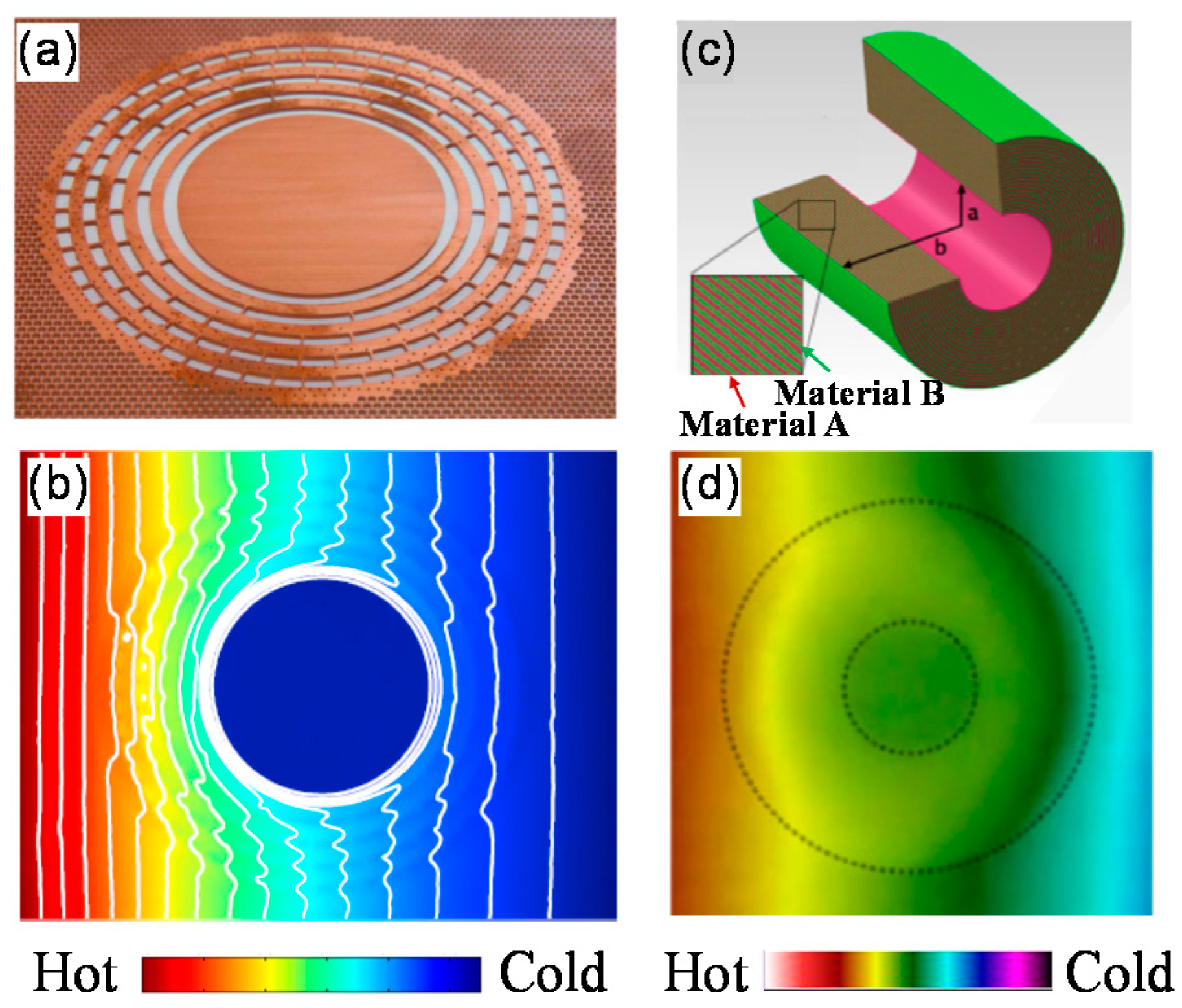


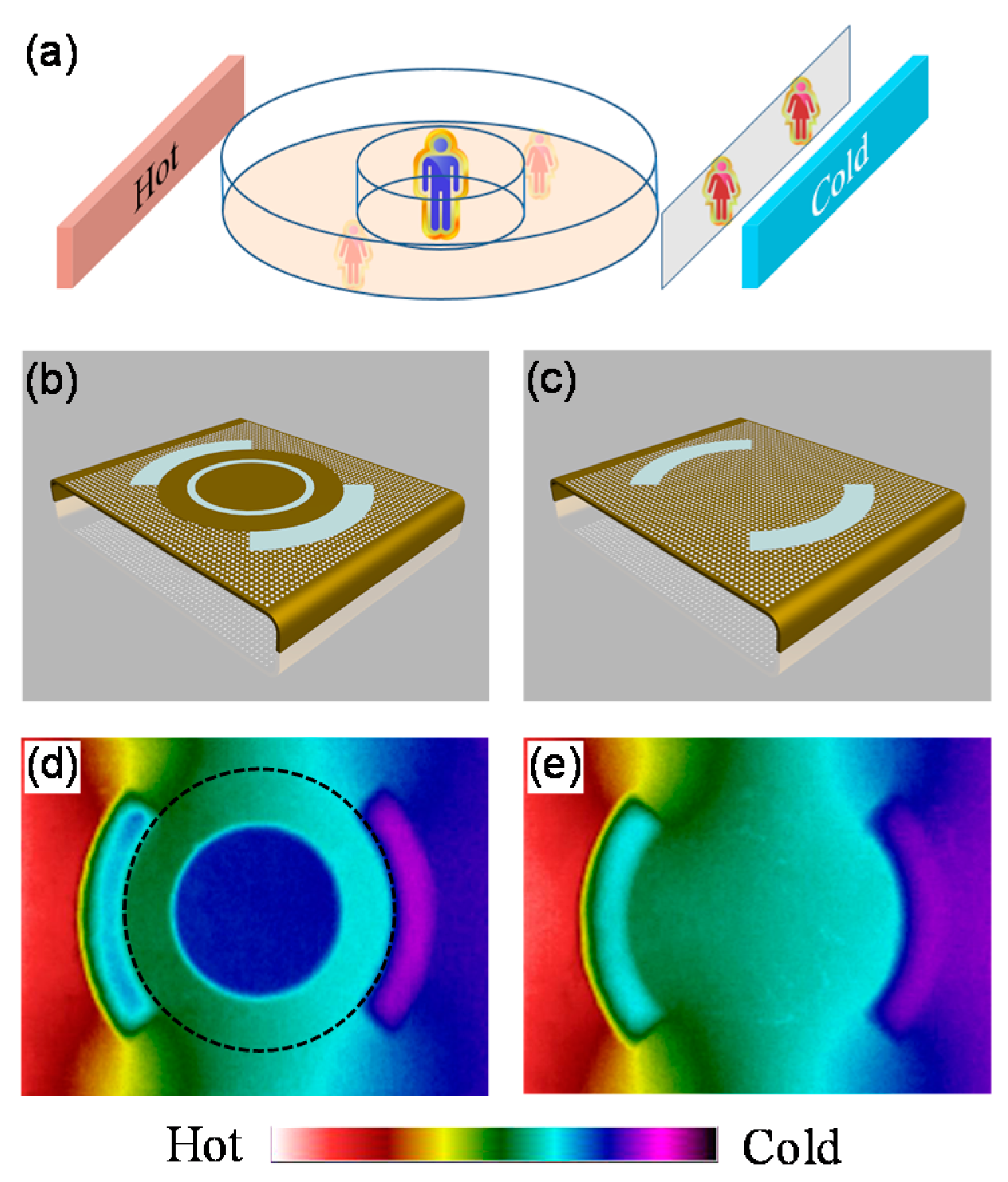
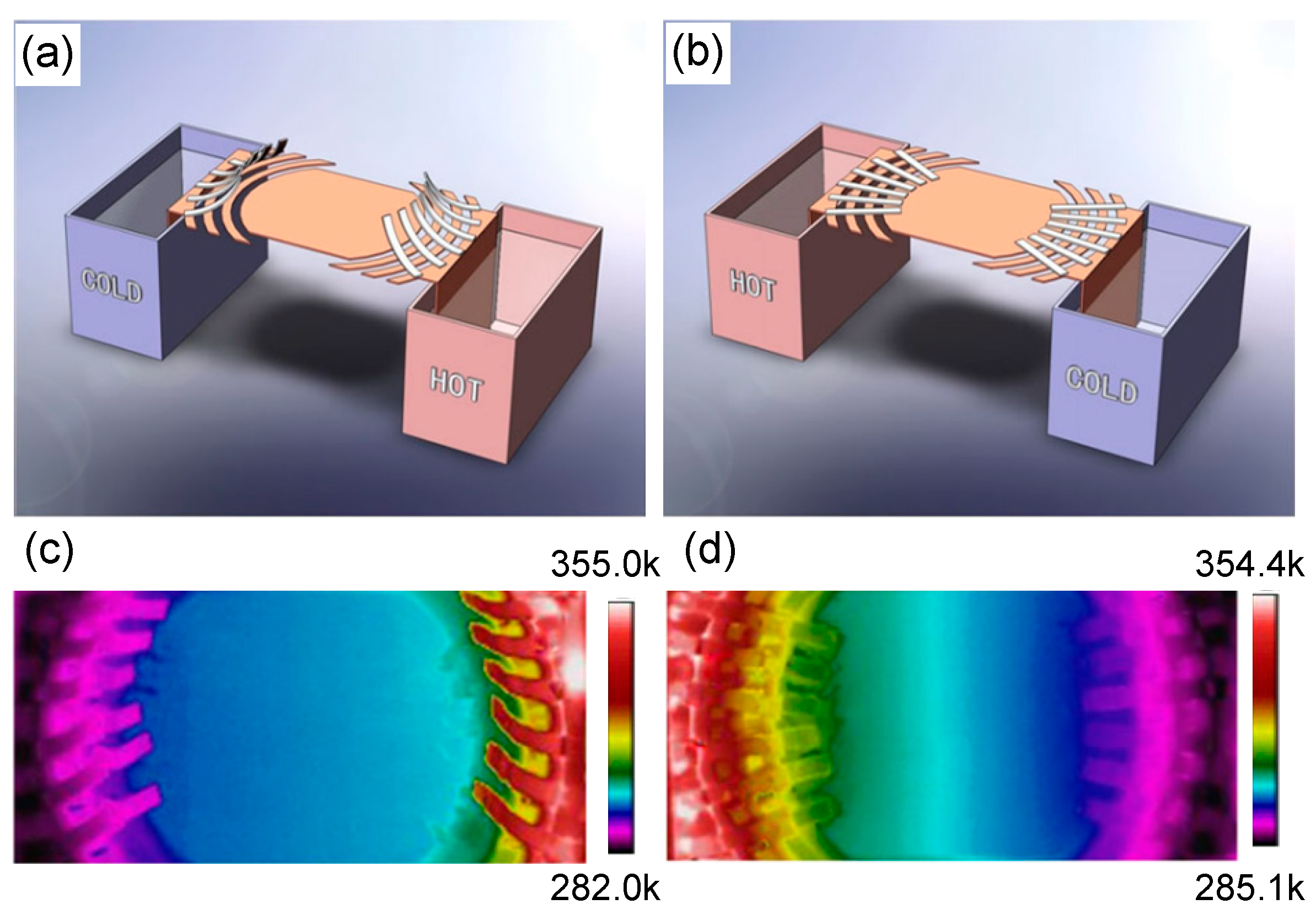

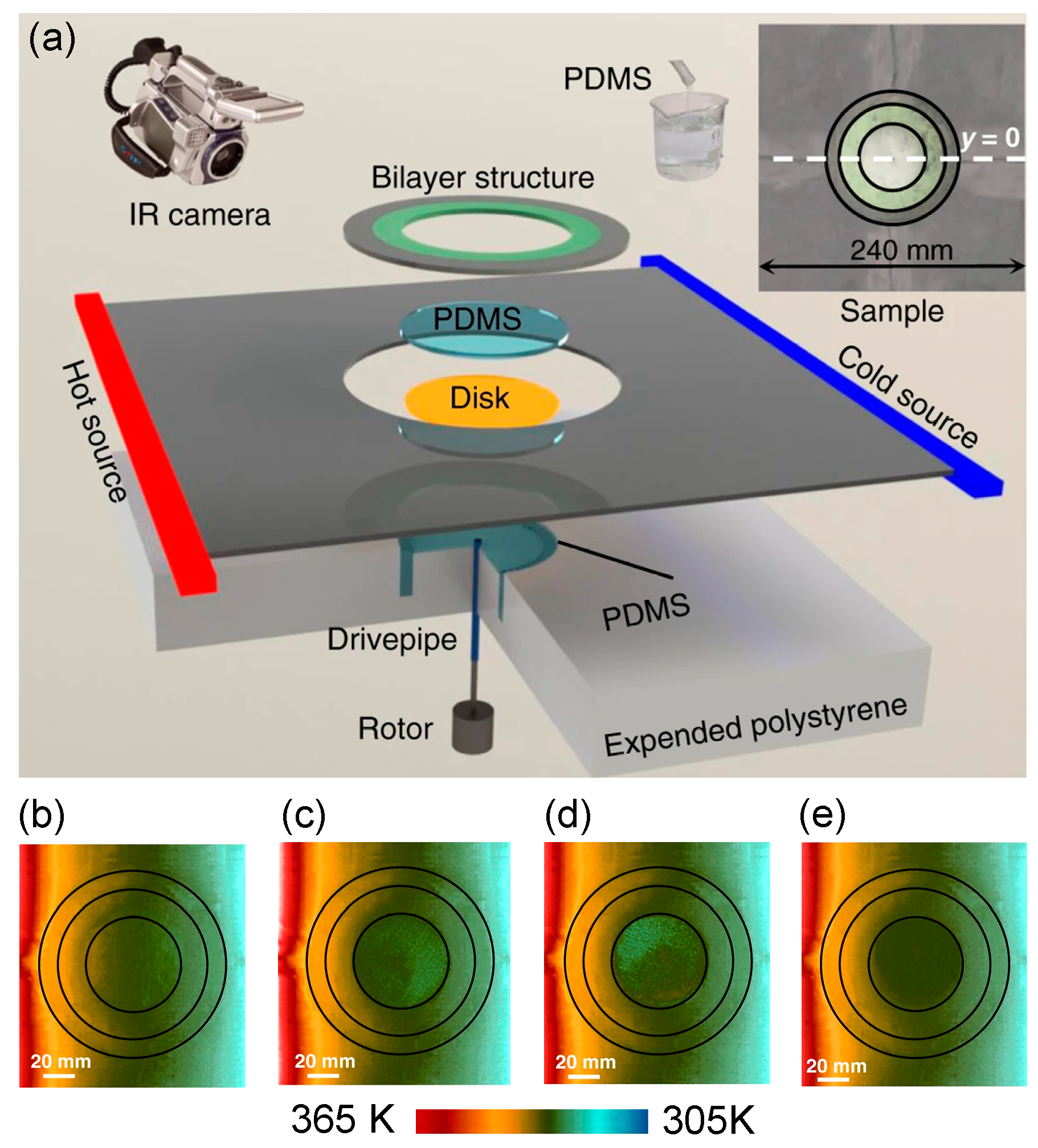
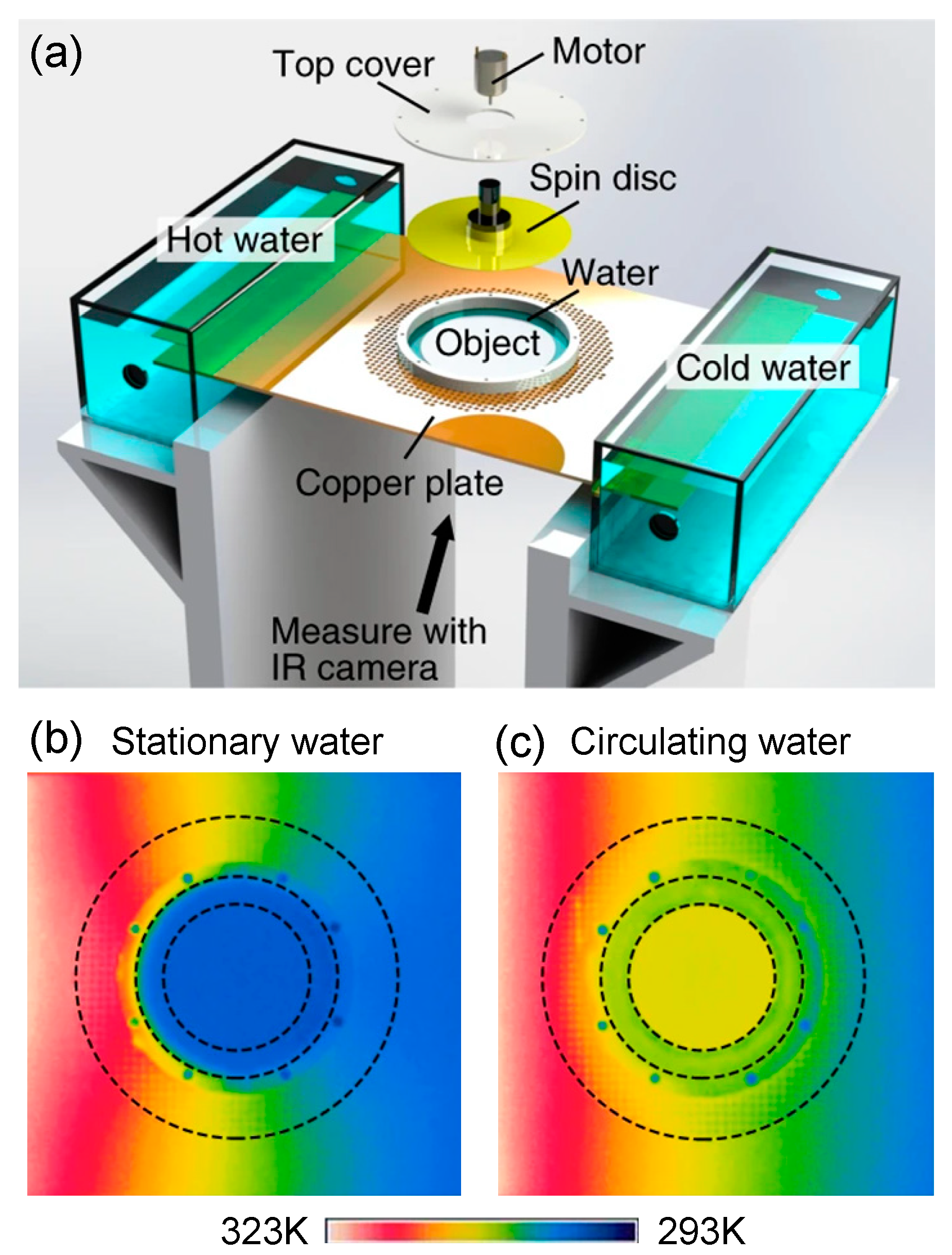
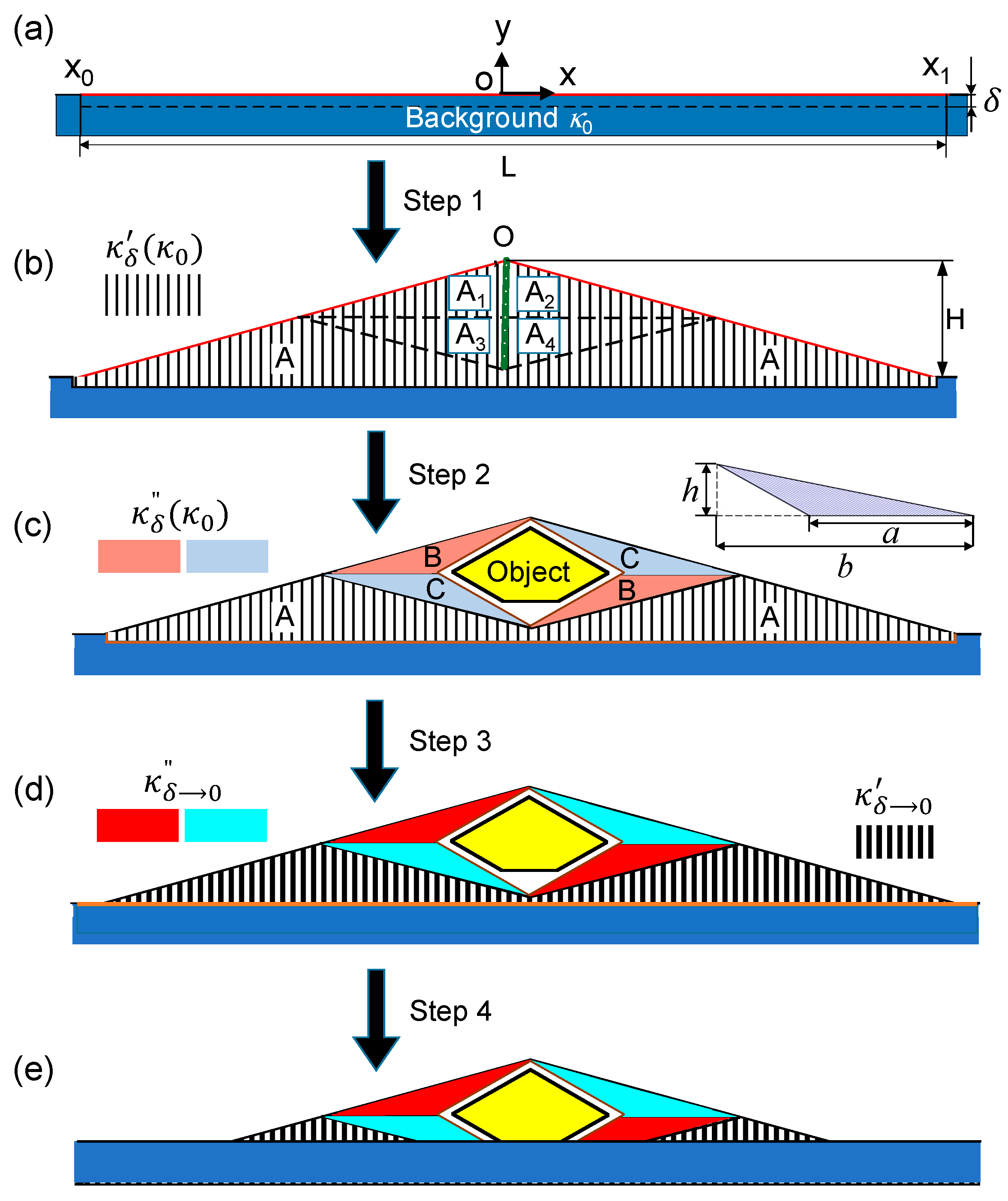
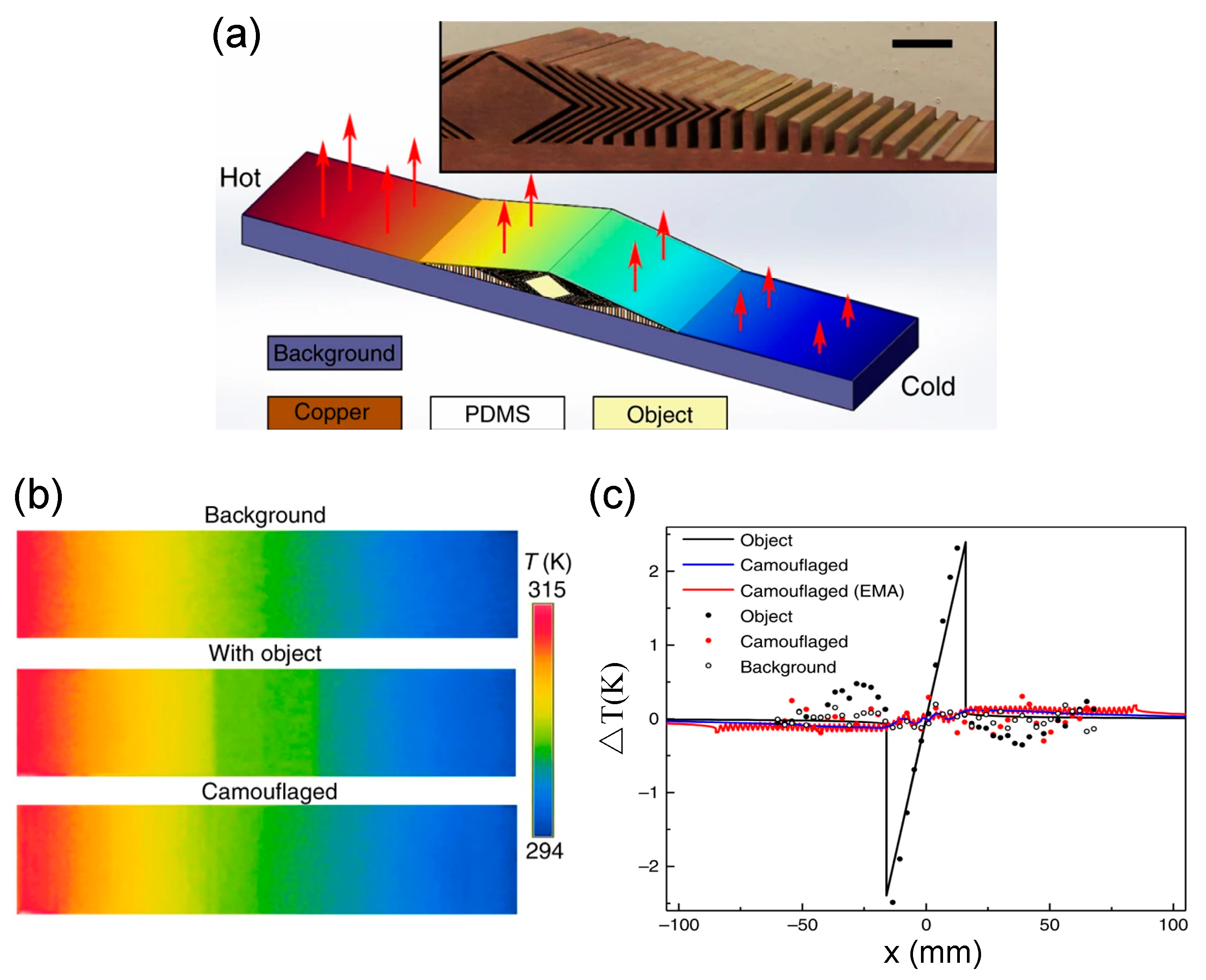
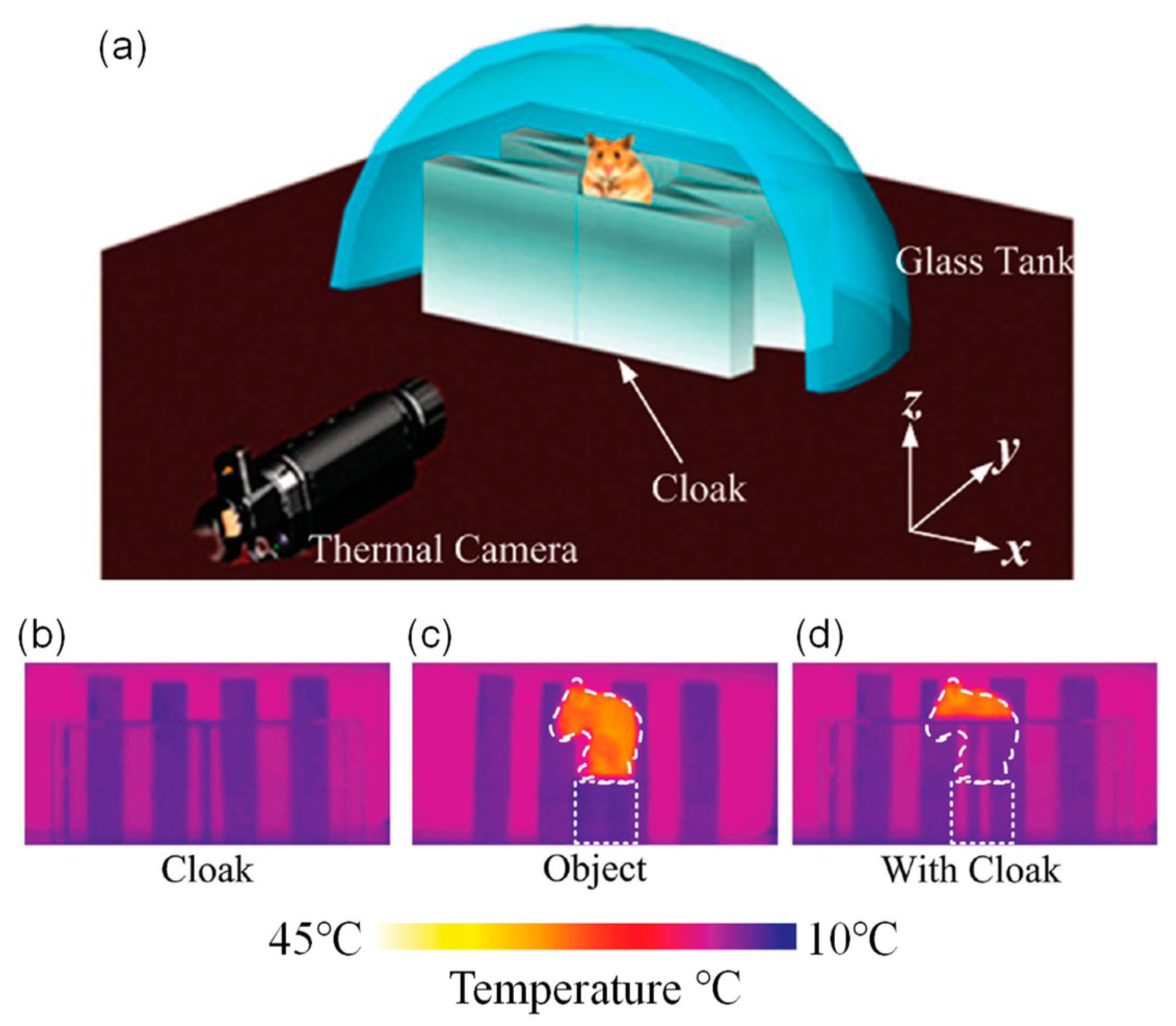
Publisher’s Note: MDPI stays neutral with regard to jurisdictional claims in published maps and institutional affiliations. |
© 2021 by the authors. Licensee MDPI, Basel, Switzerland. This article is an open access article distributed under the terms and conditions of the Creative Commons Attribution (CC BY) license (https://creativecommons.org/licenses/by/4.0/).
Share and Cite
Yue, X.; Nangong, J.; Chen, P.; Han, T. Thermal Cloak: Theory, Experiment and Application. Materials 2021, 14, 7835. https://doi.org/10.3390/ma14247835
Yue X, Nangong J, Chen P, Han T. Thermal Cloak: Theory, Experiment and Application. Materials. 2021; 14(24):7835. https://doi.org/10.3390/ma14247835
Chicago/Turabian StyleYue, Xiuli, Junyi Nangong, Peiyan Chen, and Tiancheng Han. 2021. "Thermal Cloak: Theory, Experiment and Application" Materials 14, no. 24: 7835. https://doi.org/10.3390/ma14247835




